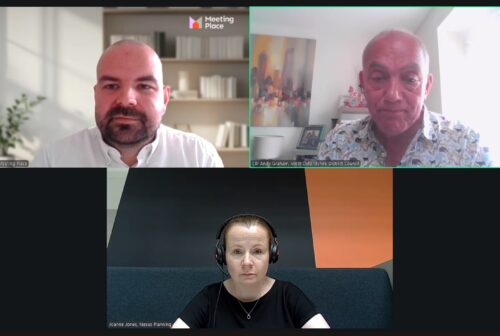Planning for change in West Oxfordshire

As West Oxfordshire prepares for a period of change, Meeting Place hosted a webinar bringing together experts from local government and the planning sector to explore what lies ahead. With governance reform on the horizon and a new Local Plan to 2041 in development, the discussion focused on the role of strategic planning, sustainability and collaboration in shaping the district’s future.
Understanding reorganisation and devolution
The webinar began with a scene-setting introduction from Councillor Andy Graham, Leader of West Oxfordshire District Council, who outlined the emerging proposals for local government reorganisation across Oxfordshire. At this early stage, three broad approaches are being discussed. One proposes extending the boundary of Oxford City to create a Greater Oxford authority. Another centres on creating two new unitary councils, while the third, put forward by the County Council, suggests a single Oxfordshire-wide authority.
Cllr Graham made clear that the council has not yet committed to any of these models. “I haven’t got a preference at this point in time,” he said. “One of the things that is really dangerous is to start making positions when you haven’t done the work behind it.” He explained that the council is in the process of gathering evidence on how services could be delivered under each option and expects to submit a preferred proposal to government in the autumn. Ultimately, the final decision will rest with ministers.
Alongside local reorganisation, a broader devolution deal is also being explored. This could lead to a new combined mayoral authority covering Oxfordshire and Berkshire, with Swindon expressing interest in joining. If progressed, it could bring with it the ability to plan strategically across boundaries, alongside significant inward investment in infrastructure, transport and housing.
Planning amid uncertainty
Joanne Jones, Associate Director at Nexus Planning, offered a consultant’s perspective on the potential implications of local government reform. She noted that clients are already asking what these changes could mean for their sites or the promotion of new land, and that many are keen to understand the likely timescales and outcomes.
She acknowledged that “at the moment, we’re all sort of crystal ball gazing,” with developers unsure about when any changes might take effect and how they could influence existing or future planning strategies. While there is clear opportunity in more strategic, joined-up working, she also raised the concern that if new structures are too broad or politically complex, this could slow progress and dilute focus.
Joanne drew comparisons with other parts of the country where reorganisation has made it harder to get plans in place, highlighting worries among clients that Oxfordshire could “be the next Buckinghamshire” in terms of delays to strategic planning. However, she welcomed the steps West Oxfordshire is taking to maintain momentum on its Local Plan during this period of uncertainty, describing that clarity as especially valuable in the absence of a fully defined future structure.
Local Plan 2041: Where things stand
West Oxfordshire’s emerging Local Plan is progressing in two parts. The first consultation focuses on policy development, while the second covers site submissions. Over 250 sites have been put forward and are currently under assessment, with further consultation expected later this year.
The council is committed to shaping a plan that responds to long-term growth needs, infrastructure pressures, and climate resilience. In-person drop-in sessions have been held across the district to engage residents and gather input on both policies and potential development locations.
A focus on sustainable and balanced growth
The council has identified a number of key priorities for development over the next 5–10 years. These include promoting net zero carbon housing, supporting affordable homes, investing in town centre revitalisation and encouraging employment space in clean and high-value sectors.
Salt Cross Garden Village is a flagship project within this vision and is intended to serve as an exemplar for sustainable development. While viability challenges are often raised by the development sector, the council is keen to work in partnership with developers to explore innovative delivery models that support long-term outcomes for residents and communities.
Joanne noted that many clients are already adapting to higher environmental standards, with sustainability now seen as a strength rather than a constraint. In several recent applications, she shared, developers have gone beyond policy baselines as part of their long-term strategy and buyer appeal.
Delivering social value through planning
Both speakers underlined the importance of ensuring that new development delivers meaningful benefits for existing and future communities. West Oxfordshire’s emerging Local Plan aims to embed social value across all policy areas: from inclusive design and access to green space, to support for education, skills and local health outcomes.
Joanne reflected on how even small-scale developments can contribute to local vitality, particularly when tailored to the needs of local residents. She gave examples of schemes supporting local sports clubs, improving shared facilities, or simply enabling families to stay close to support networks.
Looking ahead: certainty, collaboration and long-term thinking
As West Oxfordshire moves through a period of structural and policy change, the message from the webinar was clear. By progressing the Local Plan in parallel with devolution discussions, and by encouraging joined-up working across borders, the district can create a clearer framework for development and investment.
Key themes that emerged from the discussion included:
- Planning must continue, even amid uncertainty
- Strong policy direction is vital to avoid planning by appeal
- Sustainable, affordable housing is central to future growth
- Development should deliver measurable social value
- Collaboration between councils, developers and communities is key
With change comes complexity, but also opportunity. Through early engagement, evidence-led planning and open collaboration, West Oxfordshire is positioning itself to shape growth that works for the long term: for its people, its places and its future.